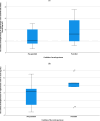Challenges and insights: Methamphetamine analysis in post-mortem putrefied human tissues in a hot climate
- PMID: 38384477
- PMCID: PMC10879005
- DOI: 10.1016/j.jsps.2024.101990
Challenges and insights: Methamphetamine analysis in post-mortem putrefied human tissues in a hot climate
Abstract
Background: The production and distribution of methamphetamine (meth) is often associated with illegal and clandestine laboratories, posing significant challenges for law enforcement and public health efforts. Global concern is growing over meth-related fatalities, as its high potential for abuse and detrimental impact on health make it an important issue in the realm of substance abuse and addiction. This concern has notably increased in Saudi Arabia, where the hot climate adds complexity to the analysis due to challenges posed by putrefaction. There is still an urgent need to enhance the screening capabilities of many toxicology laboratories to determine the cause of death, whether it be due to drug use or natural causes.
Aim: This research aimed to investigate meth concentrations in post-mortem putrefied human solid tissues in a hot climate and comparing meth metabolite concentrations in cases where signs of putrefaction were observed versus those with no signs of putrefaction. The objective is to assist criminal investigations by analyzing meth and its metabolite concentrations.
Methods: This retrospective cohort study involved postmortem samples from human subjects during autopsies conducted between 2016 and 2022. It focused on analyzing meth and its metabolite concentrations using LC-MS/MS analysis. Data on demographics, medical history, age, location, putrefaction, and other drug use were retrieved from medical records.
Results: Out of the 27 reported samples of meth and its metabolite amphetamine in both putrefied and non-putrefied biological fluids and tissues, only 8 (30%) exhibited signs of putrefaction between 2016 and 2022. Despite decomposition, detectable concentrations of meth and amphetamine were sufficient to determine the cause of death and the source of amphetamines.
Conclusion: This study found no significant difference in concentrations between putrefied and non-putrefied cases, underscoring the importance of multiple sample testing during autopsy for accurate interpretation. Each case is unique and must be considered individually.
Keywords: LC-MS/MS; Methamphetamine; Postmortem; Solid tissue.
© 2024 The Authors. Published by Elsevier B.V. on behalf of King Saud University.
Conflict of interest statement
The authors declare that they have no known competing financial interests or personal relationships that could have appeared to influence the work reported in this paper.
Figures





Similar articles
-
A Quantitative and Comparative Study of Heroin-Related Metabolites in Different Postmortem Fluids and Tissues.Toxics. 2025 Mar 20;13(3):229. doi: 10.3390/toxics13030229. Toxics. 2025. PMID: 40137556 Free PMC article.
-
Determination of pesticides in postmortem blood and bone marrow of pesticide treated rabbits.Forensic Sci Int. 2009 Aug 10;189(1-3):82-7. doi: 10.1016/j.forsciint.2009.04.017. Epub 2009 May 17. Forensic Sci Int. 2009. PMID: 19446970
-
Post-mortem CT and MR brain imaging of putrefied corpses.Int J Legal Med. 2016 Jul;130(4):1061-1068. doi: 10.1007/s00414-016-1385-5. Epub 2016 May 25. Int J Legal Med. 2016. PMID: 27225392
-
Postmortem toxicology.Forensic Sci Med Pathol. 2010 Dec;6(4):314-25. doi: 10.1007/s12024-010-9150-4. Epub 2010 Mar 4. Forensic Sci Med Pathol. 2010. PMID: 20204545 Review.
-
Neurologic manifestations of chronic methamphetamine abuse.Psychiatr Clin North Am. 2013 Jun;36(2):261-75. doi: 10.1016/j.psc.2013.02.005. Epub 2013 Apr 11. Psychiatr Clin North Am. 2013. PMID: 23688691 Free PMC article. Review.
Cited by
-
Analysis of the methamphetamine-related deaths in Eastern Saxony, Germany, between 2005 and 2019.Forensic Sci Med Pathol. 2025 May 19. doi: 10.1007/s12024-025-01023-6. Online ahead of print. Forensic Sci Med Pathol. 2025. PMID: 40389791
-
Editorial "Special Issue Clinical and Post Mortem Toxicology".Toxics. 2024 Mar 8;12(3):205. doi: 10.3390/toxics12030205. Toxics. 2024. PMID: 38535938 Free PMC article.
-
Substance misuse disorder in Saudi Arabia: A comprehensive examination of current demographic patterns, trends, and intervention requirements.Saudi Pharm J. 2024 Oct;32(10):102163. doi: 10.1016/j.jsps.2024.102163. Epub 2024 Aug 16. Saudi Pharm J. 2024. PMID: 39262681 Free PMC article.
References
-
- Al-Asmari A.I., Al-Solami F.D., Al-Zahrani A.E., et al. Post-mortem quantitation of amphetamine in cadaveric fluids in Saudi Arabia. Forensic Sci. 2022;2:222–237. doi: 10.3390/forensicsci2010017. - DOI
LinkOut - more resources
Full Text Sources

